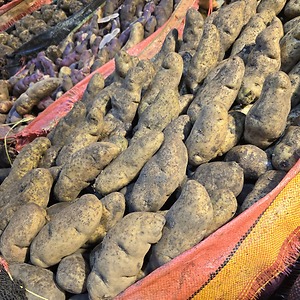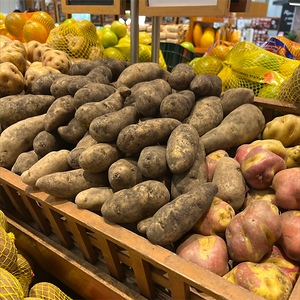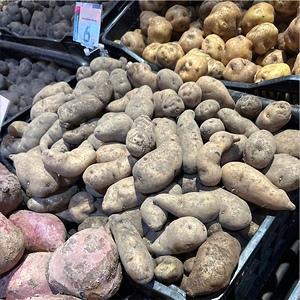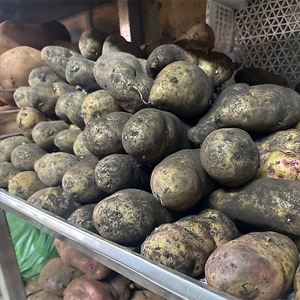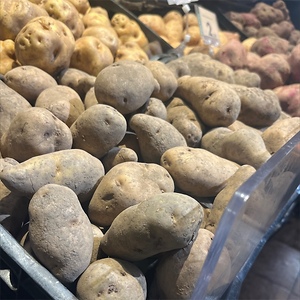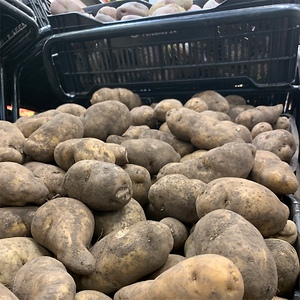


Huamantanga Potatoes
Estimated Inventory, lb : 0
Description/Taste
Huamantanga potatoes vary in size and shape, depending on growing conditions, and generally average 9 to 11 centimeters in length. The tubers are characteristically elongated and have an oblong to cylindrical shape with tapered, blunt ends. The semi-thin skin is taut, textured, and rough, showcasing golden brown coloring with dark brown marks. Some tubers also display faintly colored red spots. It is worth noting that Huamantanga potatoes are often sold in markets still covered in soil, giving them a darker colored appearance. The tuber’s eyes are typically shallow and superficial, not affecting the overall shape of the variety. Underneath the skin, the cream-colored to yellow flesh is dense, firm, and slippery when raw, developing a soft, velvety, and fluffy texture once cooked. That variety also has a high dry matter content, creating a floury consistency. Huamantanga potatoes are edible after cooking and have an earthy, mild, and neutral flavor.
Seasons/Availability
Huamantanga potatoes are available during the dry season in Peru, spanning from May through July.
Current Facts
Huamantanga potatoes, botanically classified as Solanum tuberosum, are a Peruvian variety belonging to the Solanaceae, or nightshade family. The elongated tubers are a type of native potato, also known as papa nativa, and have been grown in the highlands of the Andes Mountains in Peru for centuries. Huamantanga potatoes have since expanded beyond their native growing regions and were selected as a commercial variety for markets throughout Peru in the late 20th century. Huamantanga potatoes are also known as Juito Rojo and Ishkupuru potatoes, and the tubers are favored by growers for their flavor, texture, and hardiness, producing 1.05 to 2.15 kilograms of potatoes per plant each season. In the modern day, Huamantanga potatoes are a relatively widespread native variety in Peru and are utilized for their versatility in savory, cooked preparations.
Nutritional Value
Huamantanga potatoes have not been extensively studied for their nutritional properties. Like other varieties of potatoes, Huamantanga may be a source of fiber to regulate the digestive tract, vitamin C to strengthen the immune system, magnesium to control nerve functions, and potassium to balance fluid levels within the body. Potatoes may also provide some manganese to form connective tissues, folate to help break down certain amino acids, calcium to protect bones and teeth, phosphorus to repair tissues, and other nutrients, including vitamin K, vitamin B6, iron, and zinc.
Applications
Huamantanga potatoes have a mild and earthy taste suited for cooked preparations. The variety is known for having a thicker, creamier texture similar to yellow potatoes but a neutral taste, allowing it to be served in many different dishes. Huamantanga potatoes are often boiled and then peeled, as the skin is easily removed once cooked. The tubers are also made into fries, simmered into soups, stews, and chowders, or boiled and sprinkled in herbs as a side dish to roasted meats. In the Peruvian Andes, Huamantanga potatoes are roasted using traditional cooking methods such as huatia and pachamanca. They are also served with fried fish, drizzled in sauce in the dish papa a la huancaina, or incorporated into papas a la diable con queso derretido, a potato dish covered in spicy, melted cheese. Try boiling and mashing Huamantanga potatoes for a fluffy mixture or serving the cooked tubers with fried fish. Huamantanga potatoes pair well with tomatoes, mushrooms, leeks, aromatics such as onions, garlic, and chile peppers, spices including cloves, cumin, and paprika, herbs such as cilantro, rosemary, tarragon, and thyme, and meats such as pork, poultry, and beef. The tubers will keep up to four months when stored in a cool, dry, and dark place.
Ethnic/Cultural Info
Huamantanga potatoes are often used in stews throughout Peru and are notably incorporated into variations of ají de gallina, a traditional dish. Ají de gallina is a savory, salty stew comprised of shredded chicken, spices, chile peppers, bread or crackers, evaporated milk, onions, and garlic. The dish is considered comfort food, especially in Lima, and is typically served with potatoes such as Huamantanga. Ají de gallina is derived from a Spanish dish first carried to Peru in the 16th century. Spanish settlers often made a dish called manjar blanco, a sweet mixture of rice, flour, almonds, and sugar. This dish was also sometimes served with chicken. Manjar blanco arose from Catalonia, Spain, and the popular sweet meal is still prepared and consumed as a dessert in Spain. When the dish was made in Peru, chefs began incorporating Peruvian ingredients to create a new variation that would appeal to the local population. Aji amarillo peppers, a staple flavoring and coloring in traditional Peruvian cuisine, were added to the recipe, bread and crackers were introduced as a thickener, and pecans were substituted for almonds. The Peruvian-inspired variation became known as ají de gallina and was first served around 1839 in Lima. The dish quickly rose in notoriety and became established as a treasured Peruvian meal, still made and showcased in the modern day.
Geography/History
Huamantanga potatoes are native to South America and are descendants of wild varieties that grew naturally throughout the highlands of the Andes mountains. Much of the history of the variety is unknown, as little written records were left before the arrival of the Spanish, but it is believed that Huamantanga potatoes are one of the traditional cultivars called native potatoes in Peruvian agriculture. Potatoes are thought to have been first domesticated over 10,000 years ago in the Andes mountains, and the oldest archeological findings were sourced from areas around Lake Titicaca. Over time, potatoes were selectively bred for improved flavor, texture, and cultivation characteristics, eventually becoming one of the most essential crops within the Andes. Huamantanga potatoes are a native variety grown in high elevations from 3,700 to 4,700 meters above sea level. Historically, native potatoes were localized to the Andes, but in the modern day, native varieties, including Huamantanga, are being promoted for increased cultivation across the country. Today, Huamantanga potatoes are grown throughout Peru and are present in the regions of Cusco, Huánuco, Huancavelica, Ayacucho, Cusco, Apurimac, Junín, Ancash, and Pasco. The tubers are sold in local markets, through distributors, and in commercial grocers. The Huamantanga potatoes featured in the photograph above were sourced through markets in Surquillo and Miraflores in Lima, Peru.



